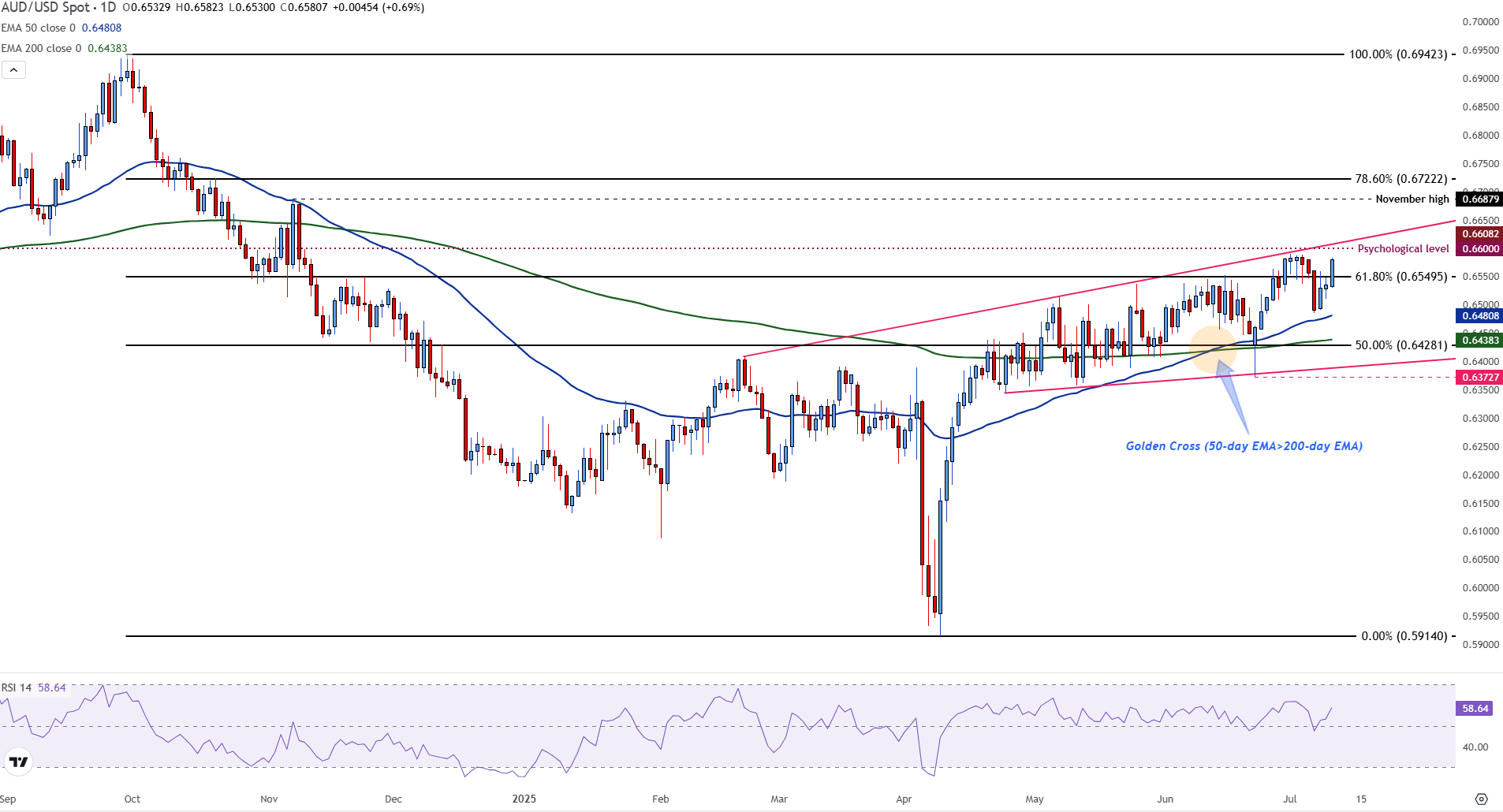AUD/USD bullish breakout potential builds above 0.6600
- US Jobless Claims and 30-year bond auction add complexity to the Fed outlook.
- AUD/USD builds bullish momentum as the pair approaches psychological resistance at 0.6600.
- US Dollar sentiment remains fragile as investors wait for clearer economic signals.
The Australian Dollar (AUD) is regaining confidence against the US Dollar (USD) on Thursday, with AUD/USD trading near 0.6580 at the time of writing. The latest move has been supported by a rebound in risk appetite and cautious sentiment surrounding the US Dollar.
US Jobless Claims and 30-year bond auction add complexity to the Fed outlook
Market sentiment in the US was lifted after the release of weekly Initial Jobless Claims numbers, which fell to 227,000, their lowest level in seven weeks, reinforcing confidence in the labor market's resilience.
However, Continuing Claims rose to a fresh multi-year high, hinting that rehiring may be slowing, adding nuance to the inflation-labor trade-off narrative.
Federal Reserve (Fed) officials, including St. Louis Fed President Alberto Musalem, struck a cautious tone on Thursday. Musalem noted that the labor market is near full employment but warned that recent US tariffs could reaccelerate inflation.
Echoing this, Fed meeting minutes released on Wednesday revealed that most officials were hesitant to cut interest rates in the near term, citing uncertainty around the duration and intensity of tariff-induced inflation.
Separately, the 30-year US bond auction, held on Thursday, cleared at 4.889%, its highest since early June. The result suggests soft demand for long-dated Treasuries and reinforces upward pressure on yields, a headwind for non-yielding assets like Gold, though it did little to derail AUD strength.
AUD/USD bullish breakout potential builds above 0.6600
The AUD/USD daily chart displays a bullish outlook, supported by a recent Golden Cross, where the 50-day Exponential Moving Average (EMA) has crossed above the 200-day EMA, a positive sign for buyers.
The pair is trading within an ascending channel and is currently threatening a break of support, found at the key 61.8% Fibonacci retracement level near 0.6550.
A successful breakout above the psychological resistance level at 0.6600 could pave the way for further gains toward the November high, around 0.6680, and the 78.6% Fibonacci level at 0.6722.

The Relative Strength Index (RSI) is near 59, indicating bullish momentum without entering overbought territory.
On the downside, the 50-day EMA at 0.6480 and the 200-day EMA at around 0.6438 provide strong dynamic support. If these levels fail to hold, the price may fall toward the 50% Fibonacci retracement, located near 0.6428. Overall, the technical structure favors continued upside as long as price remains above key moving averages and within the rising channel.
Australian Dollar FAQs
One of the most significant factors for the Australian Dollar (AUD) is the level of interest rates set by the Reserve Bank of Australia (RBA). Because Australia is a resource-rich country another key driver is the price of its biggest export, Iron Ore. The health of the Chinese economy, its largest trading partner, is a factor, as well as inflation in Australia, its growth rate and Trade Balance. Market sentiment – whether investors are taking on more risky assets (risk-on) or seeking safe-havens (risk-off) – is also a factor, with risk-on positive for AUD.
The Reserve Bank of Australia (RBA) influences the Australian Dollar (AUD) by setting the level of interest rates that Australian banks can lend to each other. This influences the level of interest rates in the economy as a whole. The main goal of the RBA is to maintain a stable inflation rate of 2-3% by adjusting interest rates up or down. Relatively high interest rates compared to other major central banks support the AUD, and the opposite for relatively low. The RBA can also use quantitative easing and tightening to influence credit conditions, with the former AUD-negative and the latter AUD-positive.
China is Australia’s largest trading partner so the health of the Chinese economy is a major influence on the value of the Australian Dollar (AUD). When the Chinese economy is doing well it purchases more raw materials, goods and services from Australia, lifting demand for the AUD, and pushing up its value. The opposite is the case when the Chinese economy is not growing as fast as expected. Positive or negative surprises in Chinese growth data, therefore, often have a direct impact on the Australian Dollar and its pairs.
Iron Ore is Australia’s largest export, accounting for $118 billion a year according to data from 2021, with China as its primary destination. The price of Iron Ore, therefore, can be a driver of the Australian Dollar. Generally, if the price of Iron Ore rises, AUD also goes up, as aggregate demand for the currency increases. The opposite is the case if the price of Iron Ore falls. Higher Iron Ore prices also tend to result in a greater likelihood of a positive Trade Balance for Australia, which is also positive of the AUD.
The Trade Balance, which is the difference between what a country earns from its exports versus what it pays for its imports, is another factor that can influence the value of the Australian Dollar. If Australia produces highly sought after exports, then its currency will gain in value purely from the surplus demand created from foreign buyers seeking to purchase its exports versus what it spends to purchase imports. Therefore, a positive net Trade Balance strengthens the AUD, with the opposite effect if the Trade Balance is negative.

